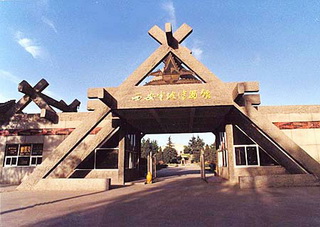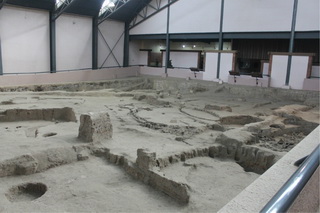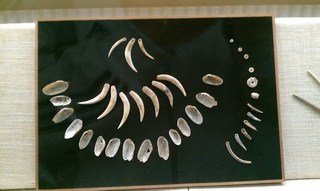 Located on the eastern outskirts of Xian, the Banpo Museum is the first on-location prehistoric relics museum in China. The Banpo Site is a typical Neolithic matriarchal community of the Yangshao Culture dating back about 6,000 years. At that time, the Banpo people used tools made primarily of wood and stone. Women, the crucial labor force, were responsible for making pottery, spinning, and raising the family, while men fished.
Located on the eastern outskirts of Xian, the Banpo Museum is the first on-location prehistoric relics museum in China. The Banpo Site is a typical Neolithic matriarchal community of the Yangshao Culture dating back about 6,000 years. At that time, the Banpo people used tools made primarily of wood and stone. Women, the crucial labor force, were responsible for making pottery, spinning, and raising the family, while men fished. Encompassing some 50,000 square meters, the museum consists of dwelling areas, a pottery-making center, and a burial ground. The size of the habitation area is about 30, 000 square meters. One fifth of the whole village (about 10,000 square meter) has already been exhumed with a surrounding moat about 5 meters deep and 6 meters wide. The cemetery is located north of the moat. To the east is the pottery-making center. The distribution of the habitation area, the pottery-making center and the cemetery reflects the Banpo people's idea of planning. Among the ruins are 46 dwellings, 2 domestic animal pens, more than 200 storage pits, six pottery kilns and 250 graves, including 73 burial jars for children. About 10, 000 artifacts have been exhumed, together with a large number of animal bones and fruit pits.
Encompassing some 50,000 square meters, the museum consists of dwelling areas, a pottery-making center, and a burial ground. The size of the habitation area is about 30, 000 square meters. One fifth of the whole village (about 10,000 square meter) has already been exhumed with a surrounding moat about 5 meters deep and 6 meters wide. The cemetery is located north of the moat. To the east is the pottery-making center. The distribution of the habitation area, the pottery-making center and the cemetery reflects the Banpo people's idea of planning. Among the ruins are 46 dwellings, 2 domestic animal pens, more than 200 storage pits, six pottery kilns and 250 graves, including 73 burial jars for children. About 10, 000 artifacts have been exhumed, together with a large number of animal bones and fruit pits.
The museum is composed of three exhibition halls for cultural relics, a main exhibition hall on the site and a temporary exhibition hall. Exhibits on display include tools and utensils. The museum was set up and opened to the public in 1958, renovated around 2005.

 China Tours
China Tours Tibet Tours
Tibet Tours China Theme Tours
China Theme Tours Off The Beaten Track
Off The Beaten Track Yangtze Cruises
Yangtze Cruises China Trip Planner
China Trip Planner Travel Agents
Travel Agents China Tours
China Tours Tibet Tours
Tibet Tours China Theme Tours
China Theme Tours Off The Beaten Track
Off The Beaten Track Yangtze Cruises
Yangtze Cruises China Trip Planner
China Trip Planner Travel Agents
Travel Agents


 0086-28-85711328
0086-28-85711328 0086-28-85546015
0086-28-85546015




 Located on the eastern outskirts of Xian, the Banpo Museum is the first on-location prehistoric relics museum in China. The Banpo Site is a typical Neolithic matriarchal community of the Yangshao Culture dating back about 6,000 years. At that time, the Banpo people used tools made primarily of wood and stone. Women, the crucial labor force, were responsible for making pottery, spinning, and raising the family, while men fished.
Located on the eastern outskirts of Xian, the Banpo Museum is the first on-location prehistoric relics museum in China. The Banpo Site is a typical Neolithic matriarchal community of the Yangshao Culture dating back about 6,000 years. At that time, the Banpo people used tools made primarily of wood and stone. Women, the crucial labor force, were responsible for making pottery, spinning, and raising the family, while men fished. Encompassing some 50,000 square meters, the museum consists of dwelling areas, a pottery-making center, and a burial ground. The size of the habitation area is about 30, 000 square meters. One fifth of the whole village (about 10,000 square meter) has already been exhumed with a surrounding moat about 5 meters deep and 6 meters wide. The cemetery is located north of the moat. To the east is the pottery-making center. The distribution of the habitation area, the pottery-making center and the cemetery reflects the Banpo people's idea of planning. Among the ruins are 46 dwellings, 2 domestic animal pens, more than 200 storage pits, six pottery kilns and 250 graves, including 73 burial jars for children. About 10, 000 artifacts have been exhumed, together with a large number of animal bones and fruit pits.
Encompassing some 50,000 square meters, the museum consists of dwelling areas, a pottery-making center, and a burial ground. The size of the habitation area is about 30, 000 square meters. One fifth of the whole village (about 10,000 square meter) has already been exhumed with a surrounding moat about 5 meters deep and 6 meters wide. The cemetery is located north of the moat. To the east is the pottery-making center. The distribution of the habitation area, the pottery-making center and the cemetery reflects the Banpo people's idea of planning. Among the ruins are 46 dwellings, 2 domestic animal pens, more than 200 storage pits, six pottery kilns and 250 graves, including 73 burial jars for children. About 10, 000 artifacts have been exhumed, together with a large number of animal bones and fruit pits.